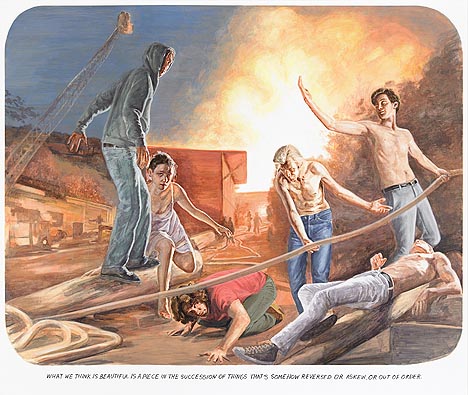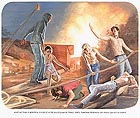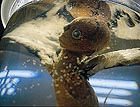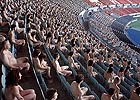
translated and summarized by: Liz Wollner-Grandville,
English summary October 13 - 19
Essl Museum: Muntean/Rosenblum – Between what was and what might be
The Caravaggio-Kids
Whoever has been to a more or less decently equipped art history museum, will experience one déjà vu after the other at the Muntean/Rosenblum exhibit at the Essl Museum. Scenes showing groups of youngsters seem to come straight out of a Neorealismo film. The protagonists are depicted in postures ranging from languish to elegant or simply musing about life under a moon-lit sky. One has come across these kinds of paintings in works by Rubens, Titian, Tintoretto, and Caravaggio. One painting shows a young man, spreading his arms like the disciple in the Supper at Emmaus, similar to a composition painted by Caravaggio 1601. And another work is based on Mantegna’s famous “Lamentation over the Dead Christ.”
The youngsters take on pretentious postures; at times their vulnerability is underlined with their nudity; and when Muntean/Rosenblum show a young man clad in white shorts, the painting invokes similarities to “Christ Bearing the Cross”. The film “Shroud”, however, borders on kitsch. It narrates the story of a man in a mobile home, a Caravaggio-youngster, and an ephebic girl, all performing unmotivated actions; or maybe no actions at all. All of this is accentuated by massive choirs – and thereby generates pathos.
Muntean/Rosenblum's style of painting is fascinating – especially because of its art historical references – and it is undoubtedly masterly. But the declamatory-artificial behaviour of these kids can be unnerving.
Essl Museum
3400 Klosterneuburg
An der Donau 1, until 01.02.2009
www.essl.museum
Kunsthaus Graz: Life? Biomorphic forms in sculpture
Sculpture, locked in a showcase
The Kunsthaus Graz deals with the topic of the exhibit “Biomorphic forms in sculpture” in an old-fashioned and unspectacular way. A classic example is the work by the Chinese artist Xiao Yu: his bizarre “Aliens”, made of anatomic specimens, set off vehement controversies. However, his small goose-bump triggering sculptures are displayed on traditional pedestals in glass cases similar to the way they would be presented in a natural history museum.
Biomorphism defines the transition from one state to the next, or the assimilation of a body shape to predefined conditions (of life). Among the works shown are Eva Helene Stern’s textile sculptures or Gerold Harold’s creations, in which he equates genetics and politics. Korean-born Lee Bul presents sculptural creations of a new man/machine (cyborg) composition floating in the air, a kind of over-artificial winged creature. Berlinde de Bruyckere’s life-like and cadaverous sculptures make a precarious impression. Next to the horribly mutilated body of a horse, she shows a monumental wax sculpture in a glass showcase. Does all of this, according to Zygmunt Bauman, symbolize a kind of “castaway life” or “human trash”? It is difficult to escape from the force of the sculptor’s work as it is from the thesis of the sociologist. In the meantime, sculpture reflects on its materiality and thereby draws on a new quality, which in turn awakens emotions und brings up difficult ethical questions.
Kunsthaus Graz
8020 Graz, Lendkai 1, until 11. 01. 2009
www.kunsthausgraz.at
hilger contemporary: Spencer Tunick – Vienna
Crowds and individuals
The American photo and performance artist Spencer Tunick is currently displaying his most recent works at the hilger contemporary; they were all created in Vienna this summer. Masses of nudes posed for Tunick’s installation at the Ernst Happel football stadium. However, the occasion for this work –the European Football Championships 2008 – turned out to be a significant weakness of Tunick’s otherwise very successful works. In the stadium, contrary to his works created in the vicinity of a city, the nudes seem rather lost and not at all disturbing.
The highlight of the exhibit is a photo of an old naked man, with a beard and long white hair, in the middle of the street, resembling a stranded sea god caught in a net. Another work shows a domino-like chain of people who have fallen over and are lying right across Vienna’s Josefstädterstrasse, with two taxis seemingly impeded by this nude-hindrance.
The artist gained fame with his mass installations in public spaces. Here he stages hundreds, sometimes even thousands, of people without clothes in such a way that an abstract 'sculpture' of nudes evolves.
The exhibit at hilger contemporary offers an exceptional opportunity to become acquainted with Tunick’s less spectacular installations. And it is definitely worth getting to know the other Tunick.
hilger contemporary
1010 Vienna, Dorotheergasse 5, until 4. 11. 2008
www.hilger.at
South London Gallery: Rivane Neuenschwander: Suspension Point
Reference structures of a point
The title of the exhibit ‘Suspension Point’ defines one of a series of points, usually three, used to indicate that something has been omitted or that a sentence is incomplete. This typographical symbol, which also marks a contextual tightening of reference points, constitutes the formal as well as the narrative axis of the exhibit. The installation is characterised by Rivane Neuenschwander’s term ‘Ethereal Materialism’. She combines minimalistic elements such as water, wood, light, and circles and demonstrates her sensitivity towards these volatile organic components.
The specifics of the main exhibition hall of the South London Gallery, with its height of six meters, constitute the starting point for Neuenschwander’s installation. This enormous hall requires that the space be divided in a new way and thereby offers display-options for additional works. The room-dividing frieze dictates the form of the wooden construction as well as the horizontal division of the space. A staircase leads from the lower exhibition level, darkened by the installation, to a second level, which is flooded with light. Here the visitor encounters the ‘Suspension Point’ (2008), an infinite row of circular holes, mirroring the now obstructed frieze. The individual points, similar to the typographical reference points, refer to a network of the existing. The hilly landscape surrounding the South London Gallery is sculptured by the wood dust, which developed by drilling the holes. The installations combine contradicting terms, such as outside/inside, day/night, and manual/automatic.
Droplets of water dripping into a basin initiate the atmospheric sound piece ‘It’s raining out there’ (2008), composed by the ephemeral sounds of the falling drops. This sound installation embraces both levels of the exhibit and thereby underlines the dualism of light and dark, respectively day and night. The projection of the film ‘Arabian Moons’ (2008) showing a frayed, flickering circle, is also integrated into this framework. ‘The Loop’, a 16mm film showing 1.001 manually drilled holes, initiates a further reference system: the infinite cycle of suspension points and the manually produced, slightly uneven series of drilled holes.
The immediate site of the exhibit space, the cartographic reference, and specifics of the surrounding landscape breaks new grounds for the ambivalence of the universal and the ephemeral. Neuenschwander's creations transform the site into a space filled with the unfolding of a network composed of flexible and temporal components. Her work is not aimed at constructing rooms, but much more at activating, transforming and developing the ephemeral elements of existent frameworks.
South London Gallery
SE5 8UH London, 65 Peckham Road, until 30. 11. 2008
www.southlondongallery.org
Mehr Texte von translated and summarized by: Liz Wollner-Grandville


 Teilen
Teilen





